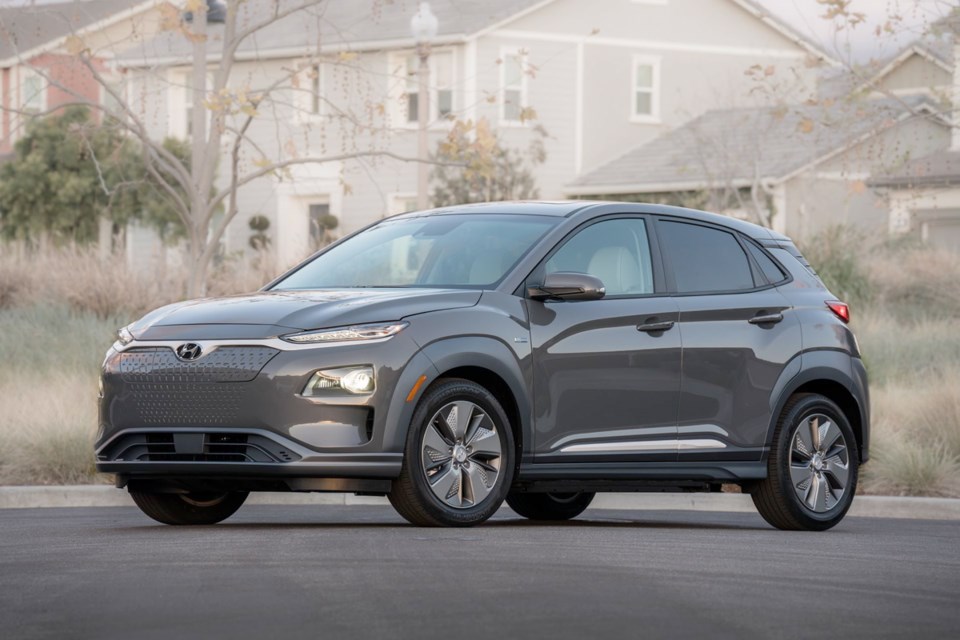Why do some electric automobiles have to look so ŌĆ” weird? ThatŌĆÖs the burning question on the SleuthŌĆÖs mind, prompted by the recent reveal of the Hyundai Kona EV. It, along with the Kia Soul EV, plus every single Tesla model, look as though they have had their mouths taped shut. ItŌĆÖs as though the designers, who might otherwise be sketching eye-catching front ends, have been given some other mandate. On the other hand, kudos to NissanŌĆÖs second-generation Leaf and the new Jaguar I-Pace for appearing normal, with attractive grille-like nosepieces. The battery pack for the 201-horsepower dimple-faced Kona EV has an official maximum-range rating of 412 kilometres. With the right charger, a top-up to 80 per cent capacity will take less than an hour. The Kona will launch in California by the end of the year and elsewhere throughout 2019.
More details on CadillacŌĆÖs new small car: The SleuthŌĆÖs intel collectors have spotted a disguised prototype of the car destined to replace the soon-to-retire ATS sedan. The new CT4 will display a chiselled appearance similar to the larger CT6 and CTS four-doors, although the CT4 will still be larger than the Audi A3 and the upcoming 2019 Mercedes-Benz A-Class. Power is expected to come from a small-displacement turbocharged gasoline four-cylinder, while a performance version will likely get a twin-turbo V-6. An all-wheel-drive option is also a distinct possibility. The CT4 is expected to arrive in late 2019 as a 2020 model, base-priced in the mid-$30,000 range in sa╣·╝╩┤½├Į.
BMW brings the 3 Series back to its sporting roots: The German automaker is secretly developing the next generation of its cornerstone sedan. The SpymasterŌĆÖs sources, however, have inside knowledge about the 2019 3 Series (code-named G20), starting with a larger grille that more clearly/loudly identifies the maker of the car. The body will be integrated with a new and stiffer modular platform that future and refreshed Bimmers will also receive. In the 3 SeriesŌĆÖ case, the result is a lower and wider stance plus a constantly adjusting (active) suspension for improved ride and greater cornering control. At launch, the base engine will be a turbocharged 2.0-litre four-cylinder thatŌĆÖs expected to make about 255 horsepower. It will be linked to an eight-speed automatic transmission. The Sleuth hopes the upcoming 3 series can improve upon the sporty essence that made past editions so desirable.
Alfa plans a new flagship sports car: The SleuthŌĆÖs sources indicate that the company will build a followup to the limited-edition ŌĆö and expensive ŌĆö 8C┬Ācoupe that arrived in North America a decade ago. The exotic second-gen Alfa that launches in 2022 uses a twin-turbocharged 2.9-litre V-6 (the same engine available in the Giulia and Stelvio Quadrifoglio models) positioned behind the cockpit, plus an electric motor connected to the front axle. The combined output is expected to be about 800┬Āhorsepower. To keep the weight down and the performance up, the 8C will be built with a carbon-fibre chassis, which is also how the current 4C sports car is constructed. The selling price is unknown at the moment, but somewhere north of $300,000 US is probable.
Ford continues to think small utility vehicles:
The Spy Guy recently reported that the Blue Oval automaker was contemplating a subcompact pickup that would be one size below the upcoming 2019 Ranger. Now there are rumours that Ford is planning a new utility vehicle that would be smaller than the upcoming 2020 Bronco. WhatŌĆÖs more, it would be built using the latest Focus car platform (available in North America as the Ford Focus Active). To date, Ford remains mum as to the name, but Timberline, Stallion Courier and Maverick are apparently on the short list.
Ups and downs
Up ŌĆö New auto-themed shows on Netflix:
The streaming-video service has two new programs in the works for subscribers to binge on. Car Masters, Rust to Riches, involves taking clapped-out classic cars and turning them into vehicles worth upward of six figures. The other 10-episode show, Hyperdrive, hosted by actress Charlize Theron, has drivers from around the world competing on a special obstacle course.
Up ŌĆö James Bond 007 Aston Martin replicas:
The automaker is planning to build 25 DB5 replicas of the car that actor Sean Connery drove in the 1964 movie Goldfinger. They will come with much of the gadgetry that was added to the original, including revolving licence plates, built-in machine guns (non-functioning, of course) and a removable passenger-side roof panel (part of the originalŌĆÖs ejector-seat system). Each non-street-legal car will cost $3.5 million US. Deliveries are to begin in 2020.



